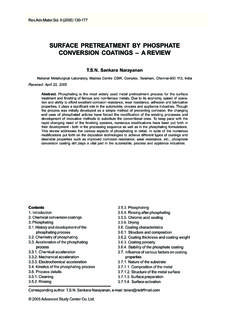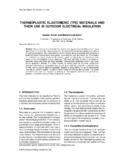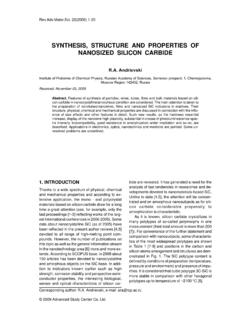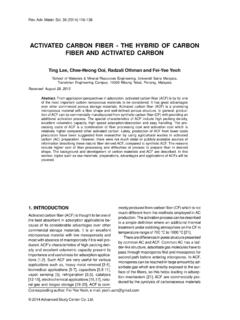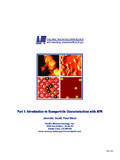Transcription of APPLICATIONS OF ION IMPLANTATION FOR …
1 Stepanov C C Rev. Adv. Mater. Sci. 30 (2012) 150-165 Corresponding author: Stepanov, e-mail: OF ION IMPLANTATION FORMODIFICATION OF TiO2: A StepanovLaser Zentrum Hannover, 30419 Hannover, GermanyKazan Federal University, 420018 Kazan, Russian FederationKazan Physical-Technical Institute, Russian Academy of Sciences, 420029 Kazan, Russian FederationReceived: December 29, 2011 Abstract. Ion IMPLANTATION can be successfully used for modification physical-chemicalproperties of TiO2. A review of APPLICATIONS for implanted TiO2 is presented and demonstratedperspectives in the fields such as magnetic data storage, nano-catalysts and optics. Solid solutionswith implanted magnetic ions demonstrated anisotropic ferromagnetism at room synthesized in titanium dioxide by IMPLANTATION with noble metal ions givepossibilities to fabricate plasmonic and optical composites.
2 Different parameters and conditionof ion IMPLANTATION technology and realized specific properties of irradiated titanium dioxideobserved and INTRODUCTIONThe search for new functional materials is one ofthe defining characteristics of modern science andtechnology. Novel mechanical, electrical, magnetic,chemical, biological, and optical devices are oftenthe result of the fabrication of new materials. Asignificant amount of research on TiO2 was performedover the last decades and a number of reviews onvarious aspects of TiO2 were published, for example[1-3]. To enhance the quality of TiO2, manyproducing methods were proposed to dope (orincorporate) trace impurity into TiO2 including: ion-assisted sputtering, chemical vapor deposition, sol-gel, chemical mixing, magnetron sputtering, and ionimplantation. A comprehensive list of dopingmethods of TiO2 is presented in a review [3].
3 Mostof the promising technology for modification andimprovement of TiO2 properties is ion IMPLANTATION [4-8] because it allows reaching a high impurity fillingfactor in an irradiated matrix beyond the equilibriumlimit of impurity solubility and, in the same time,provides controllable synthesis of metal orsemiconductor nanoparticles (NPs) at various depthsunder the substrate surface. This method allows forstrict control of the doping ion beam position on thesample surface with implant dose as, for example,in the case of electron- and ion-beam , ion IMPLANTATION is well developed and widelyused in industrial semiconductor chip and opticalwaveguides fabrication. Therefore, for instance, thecombination of ion-doped TiO2 with semiconductoror dielectric substrates by same technique as ionimplantation could be reached quite effective inpractice. Several approaches for TiO2 modificationwas recently proposed: metal-ion IMPLANTATION ofTiO2 (using transition metals such as Cu, Co, Ni,Cr, Mn, Mo, Nb, V, Fe, Ru, Au, Ag, Pt) [9-11], reducedTiOx photocatalysts [12, 13], non-metal doped-TiO2(for example, N, S, C, B, P, I, F) [14-16] and so the present review, recent advantages and someexamples on application of ion IMPLANTATION formodification of TiO2 are discussed in the frame ofnovel photocatalytic, electric, optical and magneticpropertied of doped of ion IMPLANTATION for modification of TiO2: a review2.
4 PHYSICAL AND CHEMICALPROPERTIES OF StructuresTiO2 belongs to the family of transition metal description of chemical structure of TiO2 wasdone in the review [1]. There are four commonlyknown polymorphs of TiO2 found in nature: anatase(tetragonal), brookite (orthorhombic), rutile(tetragonal), and TiO2 (B) (monoclinic) [17-20].Besides these polymorphs, two additional high-pressure forms have been synthesized from the rutilephase. These are TiO2 "" 2 structureand TiO2 (H) [22] with a hollandite : Rutile TiO2 has a tetragonal structure andcontains 6 atoms per unit cell (Fig. 1). The TiO6octahedron is slightly distorted [23-25]. The rutilephase is stable at most temperatures and pressuresup to 60 kbar, where TiO2 (II) becomes thethermodynamically favorable phase [26]. It wasfound that anatase and brookite structurestransformed to the rutile phase after reaching acertain nanoparticle size, with the rutile phasebecoming more stable than anatase for particle sizesgreater than 14 nm [27].
5 Once the rutile phaseformed, it grew much faster than the anatase. Theactivity of the rutile phase as a photocatalyst isgenerally very poor. However, it was suggested thatthe rutile phase can be active or inactive, dependingon its preparation conditions [28].Fig. 1. Crystal structures of the rutile and anatase phases of TiO2. Fragment of an image from Ref. [25].Fig. 2. Lattice structure of brookite TiO2. Fragmentof an image from Ref. [24].Anatase: Anatase TiO2 also has a tetragonalstructure but the distortion of the TiO6 octahedronis slightly larger for the anatase phase [20,24], asdepicted in Fig. 1. It was found that the anatasephase is more stable than the rutile at 0K, but theenergy difference between these two phases issmall (2 to 10 kJ/mol) [29]. The increasedphotoreactivity is because of the slightly higher Fermilevel, lower capacity to adsorb oxygen and higherdegree of hydroxylation in the anatase phase [30].
6 It was reported that the reactivity of (001) facets isgreater than that of (101) facets in an anatase crystal[31]. In the work [32] it was synthesized uniformanatase crystals containing 47% (001) facets usinghydrofluoric acid as a morphology-controlling : Brookite TiO2 belongs to theorthorhombic crystal system. Its unit cell iscomposed of 8 formula units of TiO2 and is StepanovFig. 3. Mechanism of light absorption by of an image from Ref. [33].Fig. 4. Surface band bending of the anatase (a) and rutile phases of TiO2 (b). Fragment of an image fromRef. [36].by edge-sharing TiO6 octahedra (Fig. 2). It is morecomplicated, has a larger cell volume and is alsothe least dense of the 3 forms and is not often usedfor experimental investigations [24].TiO2 is a large band semiconductor, with bandgaps of , , and eV for the anatase, rutileand brookite phases, respectively [33].
7 The valenceband of TiO2 is composed of the 2p orbitals ofoxygen hybridized with the 3d orbitals of titanium,while the conduction band is only the 3d orbitals oftitanium [34]. PhotoactivityWhen TiO2 is exposed to near-UV light, electronsin the valence band are excited to the conductionband leaving behind holes (h+), as shown in Fig. excited electrons (e ) in the conduction bandare now in a purely 3d state and because ofdissimilar parity, the transition probability of e tothe valence band decreases, leading to a reductionin the probability of e /h+ recombination [35].Anatase TiO2 is considered to be the activephotocatalytic component based on charge carrierdynamics, chemical properties and the activity ofphotocatalytic degradation of organic has inherent surface band bending that formsspontaneously in a deeper region with a steeperpotential compared with the rutile phase (Fig.)
8 4) [36]thus surface hole trapping dominates becausespatial charge separation is achieved by the transferof photogenerated holes towards the surface of theparticle via the strong upward band bending. However,in the rutile phase, the bulk recombination ofelectrons and holes occurs, so only holes very closeto the surface are trapped and transferred to was reviewed in the work [2] TiO2 representsan effective photocatalyst for water and airpurification and for self-cleaning , it can be used as antibacterial agentbecause of strong oxidation activity andsuperhydrophilicity. TiO2 shows relatively highreactivity and chemical stability under ultraviolet light( < 387nm). The development of photocatalystsexhibiting high reactivity under visible light ( > 400nm) should allow the main part of the solar spectrum,even under poor illumination of interior lighting, tobe photocatalytic mechanism is initiated by theabsorption of the photon h 1 with energy equal to orgreater than the band gap of TiO2 (~ eV for theanatase phase) producing an electron-hole pair onthe surface of TiO2 as schematized in Fig.
9 5. Anelectron is promoted to the conduction band (CB)while a positive hole is formed in the valence band(VB). Excited-state electrons and holes canrecombine and dissipate the input energy as heat,get trapped in metastable surface states, or reactwith electron donors and electron acceptors153 APPLICATIONS of ion IMPLANTATION for modification of TiO2: a reviewadsorbed on the semiconductor surface or withinthe surrounding electrical double layer of the reaction with water, these holes can producehydroxyl radicals with high redox oxidizing potential[2]. Depending upon the exact conditions, the holes,OH radicals, O2-, H2O2, and O2 itself can play im-portant roles in the photocatalytic reaction mecha-nism [37, 38].The visible light photoactivity of metal-doped TiO2can be explained by a new energy level produced inthe band gap of TiO2 in the TiO2 matrix. As shown inFig.
10 5, electron can be excited from the defect stateto the TiO2 conduction band by photon with energyequals h 2. Additional benefit of metal doping is theimproved trapping of electrons to inhibit electron-hole recombination during irradiation. Decrease ofcharge carriers recombination results in are three different main opinions regardingmodification mechanism of TiO2 doped withnonmetals [2]. (1) Band gap narrowing; (2) Impurityenergy levels; and (3) Oxygen vacancies. (1). Bandgap narrowing: it was found that N 2p state hybridswith O 2p states in anatase TiO2 doped with nitrogenbecause their energies are very close, and thus theband gap of N:TiO2 is narrowed and able to absorbvisible light [39]. (2). Impurity energy level: it wasstated that TiO2 oxygen sites substituted by nitrogenatom form isolated impurity energy levels above thevalence band [40]. Irradiation with UV light exciteselectrons in both the VB and the impurity energylevels, but illumination with visible light only exciteselectrons in the impurity energy level.
